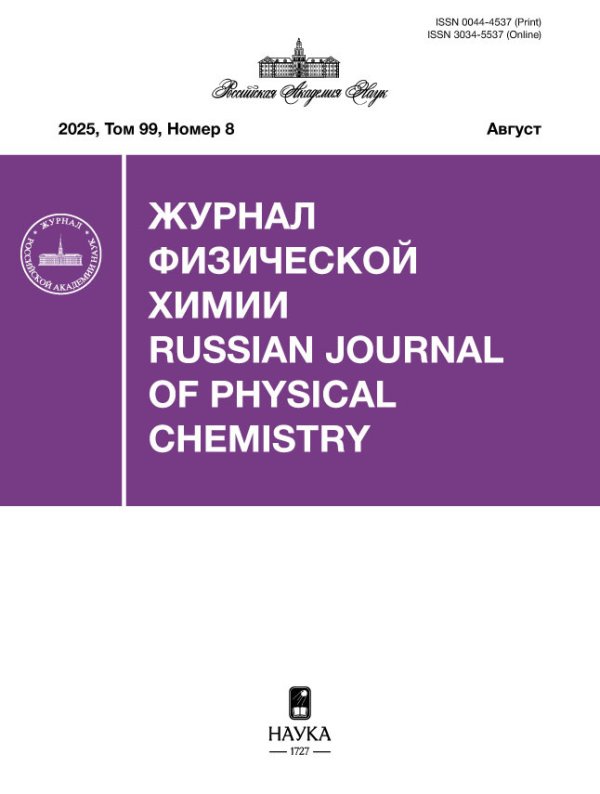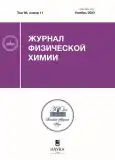Температура и энтальпия плавления нанооксидов UO₂ и ThO₂ различной морфологии
- Authors: Чернышев A.П.1,2
-
Affiliations:
- Институт химии твердого тела и механохимии СО РАН
- Новосибирский государственный технический университет
- Issue: Vol 98, No 11 (2024)
- Pages: 125-132
- Section: PHYSICAL CHEMISTRY OF NANOCLUSTERS, SUPRAMOLECULAR STRUCTURES, AND NANOMATERIALS
- Submitted: 29.05.2025
- Published: 15.11.2024
- URL: https://innoscience.ru/0044-4537/article/view/681023
- DOI: https://doi.org/10.31857/S0044453724110147
- EDN: https://elibrary.ru/EYPXYN
- ID: 681023
Cite item
Abstract
В настоящей статье термодинамическим методом изучена зависимость температуры плавления и энтальпии плавления от характерного размера и морфологии нанообъектов, состоящих из UO₂ и ThO₂. Показано, что влияние характерного размера и морфологии на энтальпию и температуру плавления нанообъектов UO₂ и ThO₂ становится заметным, когда их характерный размер составляет менее 20 нм. Резкое снижение температуры плавления происходит, когда характерный размер наночастиц, нанопроволок и тонких пленок UO₂ и ThO₂ составляет менее 5, 4 и 3 нм соответственно. Во всех случаях размерный эффект уменьшается в последовательности сферические наночастицы – нанопроволоки – тонкие пленки. Установлено, что при объединении отдельно стоящих наночастиц UO₂ и ThO₂ в наноструктурированные нанообъекты размерный эффект также уменьшается. Результаты расчетов, полученные в настоящей работе, хорошо согласуются с результатами расчетов, полученных методом молекулярной динамики и экспериментальными данными, доступными в литературе.
Full Text
About the authors
A. П. Чернышев
Институт химии твердого тела и механохимии СО РАН; Новосибирский государственный технический университет
Author for correspondence.
Email: alfred.chernyshev@solid.nsc.ru
Russian Federation, Новосибирск; Новосибирск
References
- Spino J., Santa Cruz H., Jovani-Abril R. et al. // J. Nucl. Mater. 2012. V. 422. P. 27. https://doi.org/10.1016/j.jnucmat.2011.11.056
- Khanal L.R., Sundararajan J.A., Qiang Y. // Energy Technol. 2020. V. 8. P. 1901070. https://doi.org/10.1002/ente.201901070
- Leduc J., Frank M., Jürgensen L. et al. // ACS Catal. 2019. V. 9. P. 4719. https://doi.org/10.1021/acscatal.8b04924
- Amidani L., Plakhova T.V., Romanchuk A. Yu. et al. // Phys. Chem. Chem. Phys. 2019. V. 21. P. 10635. https://doi.org/10.1039/C9CP01283D
- Gerber E., Romanchuk A. Yu., Pidchenko I., et al. // Nanoscale. 2020. V. 12. P. 18039. https://doi.org/10.1039/D0NR03767B
- Bonato L., Virot M., Dumas T.A. et al. // Nanoscale Adv. 2020. V. 2. № 1. P. 214. https://doi.org/10.1039/C9NA00662A
- Moreau L.M., Herve A., Straub M.D. et al. // Chem. Sci. 2020. V. 11. P. 4648. https://doi.org/10.1039/C9SC06117G
- Shi F.G. // J. Mater. Res. 1994. V.9. P. 1307. https://doi.org/10.1557/JMR.1994.1307
- Jiang Q., Wen Z. Thermodynamics of Materials. Berlin Heidelberg Higher Education Press, Beijing and Springer-Verlag, 2011, 298 p.
- Yang C.C., Mai Y.-W. // Materials Science and Engineering R: Reports. 2014. V. 79. P. 1.
- Боярченков А.С., Поташников С.И., Некрасов К.А., Купряжкин А.Я. // Расплавы. 2012. № 2. С. 32. Boyarchenkov A.S., Potashnikov S.I., Nekrasov K.A., Kupryazhkin A. Ya. // Russian Metallurgy (Metally). 2012. V. 8. № 8. P. 676. https://doi.org/10.1134/S0036029512080034
- Boyarchenkov A.S., Potashnikov S.I., Nekrasov K.A., Kupryazhkin A.Ya. // J. Nucl. Mater. 2012. V. 427. P. 311. https://doi.org/10.1016/j.jnucmat.2012.05.023
- Махмуд-Ахунов Р.Ю., Тихончев М.Ю., Светухин В.В. // Журн. Техн. физики. 2013. Т. 83. № 8. С. 8. Makhmud-Akhunov R. Yu., Tikhonchev M. Yu., Svetukhin V.V. // Technical Physics. 2013. V. 58. № 8. P. 1094. https://doi.org/10.1134/S1063784213080197
- Cappia F., Hudry D., Courtois E. et al. // Mater. Res. Express. 2014. V. 1. P. 025034. doi: 10.1088/2053-1591/1/2/025034
- Cappia F., Jovani-Abril R., Spino J. et al. // Prog. Nucl. Energy. 2014. V. 72. P. 11. https://doi.org/10.1016/j.pnucene.2013.10.018
- Wilde G. // Advanced Engineering Materials. 2021. V. 23. P. 2001387. https://doi.org/10.1002/adem.202001387
- Guéneau C., Chartier A., Fossati P., et al. Comprehensive Nuclear Materials. V. 7. Amsterdam: Elsevier, 2020. P. 111–154. https://doi.org/10.1016/B978-0-12-803581-8.11786-2
- Manara D., Ronchi C., Sheindlin M. et al. // J. Nucl. Mater. 2005. V. 342. P. 148. https://doi.org/10.1016/j.jnucmat.2005.04.002
- Konings R.J.M., Beneš O., Kovács A. et al. // J. Phys. Chem. Ref. Data. 2014. V. 43. P. 013101. https://doi.org/10.1063/1.4825256
- International Atomic Energy Agency. Thermophysical properties database of materials for light water reactors and heavy water reactors. Final report of a coordinated research project 1999–2005, Non-serial Publications / Ed. by Cognet G., Efanov A., Fortov V. et al. Vienna, IAEA-TECDOC-1496, IAEA, 2006. 397 p.
- Gilvarry J.J. // Phys. Rev. 1956. V. 102. № 2. P. 308. https://doi.org/10.1103/PhysRev.102.308
- Бацанов С.С. // Журн. физ. химии. 2012. Т. 86. № 11. С. 1890. Batsanov S.S. // Russ. J. Phys. Chem. V. 86. P. 1759. https://doi.org/10.1134/S0036024412110052
- Leinders G., Cardinaels T., Binnemans K., Verwerft M. // J. Nucl. Mater. 2015. V. 459. P. 135. https://doi.org/10.1016/j.jnucmat.2015.01.029
- Zhu Y.F., Lian J.S., Jiang Q. // J. Phys. Chem. C. 2009. V. 113. P. 16896. https://doi.org/10.1021/jp902097f
- Zhu Y.-F., Zhao N., Jin B. et al. // Phys. Chem. Chem. Phys. 2017. V. 19. P. 9253. https://doi.org/10.1039/C6CP08061H
- Hall R.O.A., Mortimer M.J. // J. Nucl. Mater. 1987. V. 148. P. 237. https://doi.org/10.1016/0022-3115(87)90017-1
- Jin M., Khafizov M., Jiang C. et al. // J. Phys. Condens. Matter. 2021. V. 33. P. 275402. https://doi.org/10.1088/1361-648X/abdc8f
Supplementary files















